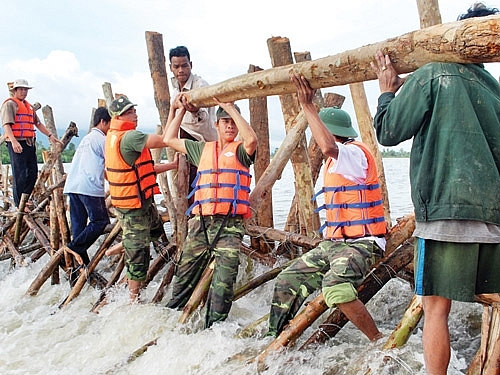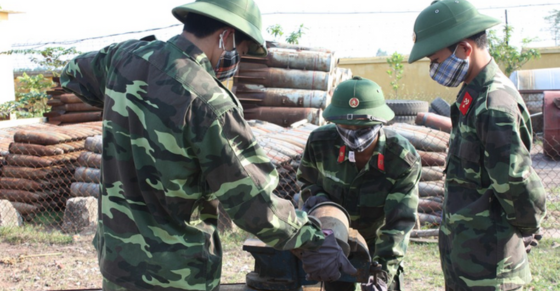Estimated land use needs to implement Natural Disaster Prevention Planning in Vietnam
What are the estimated land use needs to implement Natural Disaster Prevention Planning in Vietnam?

Estimated land use needs to implement Natural Disaster Prevention Planning in Vietnam (Internet image)
Estimated land use needs to implement Natural Disaster Prevention Planning
Content mentioned in Decision 145/QD-TTg of 2024 approving Plans, policies and solutions to implement the Planning for natural disaster prevention and control and irrigation for the period 2021-2030, with a Vision to 2050 issued by the Prime Minister.
The expected land use needs for implementing the Natural Disaster Prevention and Control Planning are as follows:
- Total land use demand for implementing planning solutions according to Decision 847/QD-TTg in 2023 is about 136,500 hectares, of which the land demand for construction of upgrading and repair works is 34,000 hectares and for new construction projects is 102,500 hectares.
- The Ministry of Agriculture and Rural Development, during the process of formulating specialized technical plans, continues to collaborate with localities and relevant agencies to review land use needs and invest in accordance with the criteria for national land use from 2021 to 2030, with a vision Towards 2050, and the 5-year national land use plan for 2021-2025 that has been authorized and approved, ensuring efficient and compliant land use.
Objectives of Natural Disaster Prevention Planning in Vietnam
According to Decision 847/QD-TTg in 2023, the general goals of the Planning for Natural Disaster Prevention and Control and Irrigation for the period 2021-2030, with a vision to 2050 are as follows:
Ensuring water supply, drainage and drainage for people's livelihood, agricultural production, economic sectors and environmental protection; Improve capacity to prevent, combat and reduce damage caused by natural disasters, contributing to sustainable socio-economic development, ensure water security, adapt to climate change and develop upstream of inter-national rivers.
**Specific goals until 2030
- Regarding water supply
+ Sufficient water supply for daily life; Providing and creating water sources for rural, urban, industrial, economic zones...; Meet water needs for coastal economic activities and densely populated islands. Proactively source local water for daily life in areas affected by drought, water shortage, and saltwater intrusion; focus on some areas with special difficulties in water resources, areas frequently affected by drought, saltwater intrusion, floods, inundation, and waterlogging. Actively control salt and fresh water in estuaries and coastal areas.
+ Proactive irrigation water supply for 2-crop rice areas with a guaranteed frequency of 85%, especially in the Red River Delta, guaranteed 85-90%, for areas with difficulty in water sources and irrigation solutions (mountainous, border, coastal, island) guaranteed 75-85%; Combine water-saving irrigation solutions.
+ Ensure water supply for 70% of shallow crop areas, gradually increase the frequency of irrigation for vegetables to 90%, fruit trees and perennial industrial plants to 90-95%. Ensure adequate water supply for livestock and poultry with about 10.5 million animals. Active water supply and drainage for 1.35 million hectares of concentrated intensive aquaculture.
+ Replenish water sources on polluted rivers, canals, and irrigation systems, contributing to improving the environment and ensuring water quality that meets water use requirements.
- Regarding drainage and sewerage: Ensuring water drainage through irrigation works for about 3.5 million hectares of agricultural and fishery production land and urban and industrial land areas with a design rain frequency of 10%. Actively drain and drain water to the main river, increase drainage area by motivation; Maintain area to store and regulate rainwater, especially in urban areas and concentrated residential areas.
- Regarding flood prevention and control, inundation and other types of natural disasters
+ Red-Thai Binh river system: flood protection with a frequency of 0.33% for areas under the regulatory influence of large upstream reservoirs, 1% to 2% for areas less under the regulatory influence of large reservoirs. Some cities in the province such as Yen Bai and Son La prevent floods with a frequency of 5%; Bac Giang, Thai Nguyen, Tuyen Quang fight floods with a frequency of 2%; Viet Tri and Lang Son prevent floods with a frequency of 0.33% to 1%. Hanoi city center on the right bank of the Red River resists floods with a frequency of 0.2%. River areas without dykes upstream ensure flood drainage frequency according to regulations in each area.
+ Ma and Ca river systems: the downstream area resists floods with a frequency of 0.6% to 1%, Ngan Pho and Ngan Sau rivers resist floods with a frequency of 2%; Huong River ensures flood drainage with a frequency of 7%; The downstream of Tra Khuc river ensures flood drainage with a frequency of 10%, the downstream of Kon - Ha Thanh and Ba rivers ensures flood drainage with a frequency of 5%.
+ The remaining rivers proactively prevent and adapt to floods to protect the population, fight early and late floods with a frequency of 5% to 10% to protect production.
+ Large urban areas, Ho Chi Minh City, Binh Duong, Dong Nai fight main-season floods with a frequency of 5%, Can Tho city and urban areas in the Mekong Delta provinces are guaranteed to fight floods with a frequency of 1%, production areas all year long fight floods with a frequency of 2%, and other regions proactively live with floods.
+ Gradually improve the capacity to prevent flash floods, landslides and other types of natural disasters, ensuring life safety for people and infrastructure.
**Vision to 2050
- Provide enough water source for daily life with a 100% guaranteed level; Providing and creating water sources for rural areas, urban areas, industries, economic zones, etc. Meet water needs for coastal economic activities and densely populated islands.
- Proactive irrigation water supply for the entire irrigated rice area with a guaranteed frequency of at least 85%, the Red River Delta region alone with a guaranteed frequency of from 90% to 95%, proactively dealing with extreme scenarios, improving water-saving irrigation rates.
- Increase the area of irrigated dry crops to 100% with a guaranteed irrigation frequency of 90% to 95%. Ensuring enough water supply for 13 million livestock and poultry. Proactive water supply and drainage for over 1.4 million hectares of concentrated intensive aquaculture.
- Completely overcome water pollution in rivers, canals, and irrigation systems.
- Actively drain and drain water through irrigation works for crops, fisheries, and urban and industrial land areas, gradually increasing the design rain frequency from 5% to 10%.
- Proactively supply enough water for daily life when drought, lack of water, and saltwater intrusion occur. Completely solve domestic water problems in areas with especially difficult water sources.
- Flood prevention and control: the Red River-Thai Binh river system, gradually considers raising the flood protection level with a frequency of 0.2% for areas affected by regulation of large reservoirs upstream; Hanoi city center on the right bank of the Red River ensures flood protection with a frequency of 0.14%; and the river mouth area protects against floods with a frequency of 0.33%. Flood protection for Ho Chi Minh City and Binh Duong has a frequency of 1%.
- Number of deputy directors of departments in Vietnam in accordance with Decree 45/2025/ND-CP
- Cases ineligible for pardon in Vietnam in 2025
- Decree 50/2025 amending Decree 151/2017 on the management of public assets in Vietnam
- Circular 07/2025 amending Circular 02/2022 on the Law on Environmental Protection in Vietnam
- Adjustment to the organizational structure of the Ministry of Health of Vietnam: Certain agencies are no longer listed in the organizational structure
- Vietnam aims to welcome 22-23 million international tourists in Vietnam in 2025
-

- Emergency response and search and rescue organizations ...
- 10:29, 11/09/2024
-

- Handling of the acceptance results of ministerial ...
- 09:30, 11/09/2024
-

- Guidance on unexploded ordnance investigation ...
- 18:30, 09/09/2024
-

- Sources of the National database on construction ...
- 16:37, 09/09/2024
-

- General regulations on the implementation of administrative ...
- 11:30, 09/09/2024
-

- Notable new policies of Vietnam effective as of ...
- 16:26, 11/04/2025
-
.Medium.png)
- Notable documents of Vietnam in the previous week ...
- 16:21, 11/04/2025
-
.Medium.png)
- Notable documents of Vietnam in the previous week ...
- 16:11, 02/04/2025
-
.Medium.png)
- Notable new policies of Vietnam to be effective ...
- 16:04, 02/04/2025
-
.Medium.png)
- Notable new policies of Vietnam effective from ...
- 14:51, 21/03/2025

 Article table of contents
Article table of contents
